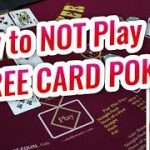Poker Strategy Info And Source:
Like it or not, #poker is all about making assumptions. Make good assumptions and it’s much easier to choose the right play. Make bad assumptions and it’s tough to make any profit. And what if you abandon making any assumptions at all!?
In this video, I respond to a question left by Roger on “The Basics Of Poker EV” video. Roger says “Making a TON of assumptions re what the SB would shove with. this is where the entire thing falls down.” See if you agree with the reply!
00:00 Good Morning
00:21 Roger’s Comment
00:52 Context
01:12 Assumptions In EV Calculations
01:57 Assume Better
02:55 What Is The Alternative Approach
04:12 Variables And Formulas
05:49 Practicing Postflop
*GRAB THE POSTFLOP WORKBOOK*
https://www.splitsuit.com/postflop-poker-workbook
*RELATED CONTENT*
· Most $2/$5 Players Mess This Hand Up: https://youtu.be/mwfSvSns8Vc
· The Original Basics Of EV Video: https://youtu.be/jiPmaif9szQ
· The Poker EV Formula: https://www.splitsuit.com/simple-poker-expected-value-formula
*FOLLOW ME ON SOCIAL*
· Discord: https://redchippoker.com/discord
· Twitter: https://twitter.com/splitsuit
· Facebook: https://www.facebook.com/splitsuit
· Instagram: https://www.instagram.com/splitsuit
Source: YouTube






 2022-11-14
2022-11-14

I mean, there are always two sides to anything, right? At least.
I just usually like to give my thoughts and add a little explanation. I think, that's better than just saying "you're wrong, lol" and giving absolutely NO further explanation. Like some smart asses do…
In general I am VERY happy for different viewpoints than mine. It's the only way, I can learn. But when they come in the style of "you're an guy and I know it WAY better", well then the learning process isn't gonna be quite that effective, right? Even with the simplest type of discussion, people should learn to empathize with the other person, too before bringing their own viewpoint to the table. ESPECIALLY online!
Aren't you that guy who played 1/2 at Orange City? You somehow have 107k subs!
Anyone making a comment harping on the fact you made assumptions is funny in the sense that they clearly failed to notice the assumptions they were making.
I think some people want an exact answer on what to do in every situation. Once there is a situation where they have to make a decision with incomplete information they fall apart. They need certainty
Thanks again for the clear words – assessments are individual and an important building block to success.
You quite rightly point out that we have to make assumptions, and that when critiquing assumptions, we should always be asking what is the alternative approach / what are better assumptions.
And in this exact case (in the BB, villain shoving 12bb from SB), you could have made some much better assumptions. Specifically, in very shallow stack / low SPR scenarios, a good approach is to try for GTO — assume your opponent will not make major mistakes because there just aren’t enough blinds on the table to make a huge mistake (except perhaps, as we will get to, preflop).
And the solver says this is a shove-or-fold scenario for villain. Which makes sense: by pure Sklansky-Chubukov ranking, villain can profitably jam 36.3% of their hands face up (still profitable to jam over a third of the range when we can see their actual cards and play perfectly).
Solver says they should be banging 56-57% of their range, which intuitively makes sense because they aren’t actually flipping the cards face up, and get to work in a decent number borderline hands / bluffs.
Our MDF (minimum defense frequency) needs to be around top 30% of our range to keep them from profitably jamming absolute nonsense like J4o, or 72s.
And this is the one place in the hand where it is possible to make a huge mistake. Let’s say SS’s incredibly tight range (77+, AJ+, KQ = 8.4%) is what they’re actually shoving. Sighing and calling down our top 30% doesn’t kill us.
But let’s say we’re up against a thinking/GTO player — or even someone who just studied a couple pushbot shove charts for tournaments. Assuming the tight range, we will only have pot odds to call down with our top 5.1% (99+, AQ+), and we will be folding 95% (!) of our hands and just throwing away a boatload of equity (AJ, AT, KQ, 88, etc. all go in the muck against an opponent who is going to be correctly shoving 57% — including stuff like Q8o and 96s!).
The default assumption should always be that your opponent (especially when short stacked) will play accurately. And the best approach is to (1) figure out that baseline of what is actually the accurate/GTO way to play the hand, (2) identify ways where you can get heavily exploited (in this case over-folding), (3) identify potential weaknesses / mistakes your opponent may be making (based on evidence/observation, not guesses/gut feelings/stereotypes) and game plan how to best exploit them.
So, yes, without huge evidence that villain is insanely tight, the commenter is correct, your assumption of the insanely tight range was not the best assumption you could have made.
Is assumption the correct word?
Or, is the word estimate more accurate?
Here's a simple example:
If I have enough data, to be confident that a player raises the button about 30% of the time when it folds around to them, I can make a fairly accurate estimate of what their range looks like.